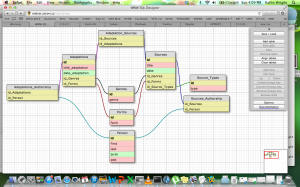Community
June 13, 2013
Reflections on DHSI 2013: Or How I Learned to Love Databases and Acronyms (“RoDHSIoHILLDA”)
Ramping up in the wake of Congress, this year’s Digital Humanities Summer Institute, or “DHSI” for the acronym-inclined, gathered an unprecedented number of scholars, students, and researchers for training in, you guessed it, the digital humanities. Thanks to support from the Editing Modernism in Canada project (“EMiC”), a course on Digital Humanities Databases was my home for the intensive five-day summer institute that punctuates class time with colloquium and unconference sessions.
Taught by Harvey Quamen, Jon Bath, and John Yobb, the Digital Databases class led us through project planning, MySQL coding (Structured Query Language), database building, and finally, database queries that enable you to ask specific research questions. In short, I mapped out and built a database on Canadian literary adaptations in five days (however minimally populated it may be). When organizing the structure of my database and its multiple tables, I found it very helpful to think of the connected tables as a sentence: there is usually a subject (e.g. person), verb (e.g. adapting), and object (e.g. source). As with literary work, I learned that too much repetition is a bad sign and that spelling counts; the latter was quite horrifying for someone like me who is codependent on autocorrect because there is no autocorrect or red underline to aid in spelling or typos. I also made sure to take advantage of the one-on-one help from Harvey and the Jo(h)ns.
Andrea Hasenbank—an EMiC Doctoral Fellow—introduced the class to a free, online website called “SQL Designer” that not only enabled me to map out nine inter-related tables but also created the MySQL commands. Although seemingly sent from the digital gods, it still requires a background in MySQL in order to understand how to use, navigate, and implement the Designer, but the first three days of the Digital Databases course covers many of the database-specific commands and related structures. For those interested in taking the course and/or trying out SQL Designer, I have a few tips from a novice’s perspective:
– Be sure to save the database design often; I saved mine in my browser under a unique name.
– There is a button that will create foreign keys for you (which link two tables together). At first, I typed in all the foreign keys myself before discovering that the Designer will create and appropriately name foreign keys in junction tables. (For those unfamiliar with databases yet, fret not, this jargon will be all too clear by the end of the course’s first day.)
– There were some glitches for me in the MySQL Code, such as the repetition of the “null” command and the addition of “primary key” commands in junction tables that included no primary keys. Also, be sure to erase the last comma in a list of commands before the closing bracket and/or semicolon.
– I needed to edit the generated MySQL commands in a text editor (such as Text Wrangler) before inputting it into Terminal.
Here is a sample draft of my database design in SQL Designer:
You will notice that the SQL Designer can also encode the column type (primary id, date, foreign key, etc.).
My research investigates how Canadian literature rewrites popular narratives—Greek myth, Shakespearean plays, colonial legend, national histories—by changing the identities of marginalized characters. I examine Canadian revisionist plays that critique cultural figures like Philomela, Othello, and Pocahontas as reductive emblems of layered racial, sexual, and gendered identities. The digital Canadian Adaptations of Shakespeare Project, or if you haven’t had enough exciting acronyms, “CASP,” features an online database that has been integral to my research (Daniel Fischlin). Building on CASP, I am interested in creating a database that encompasses multiple sources and enables researchers or students to search Canadian adaptations of Greek mythology, the Bible, and Native mythology, to name a few. You could also, for instance, limit your search by author, date, and/or location that would list all the Canadian adaptations of Ovid, during post-WWI Canada, and/or in Nova Scotia. This database would help establish a wider field of Canadian adaptation studies.
The Digital Humanities Databases course cemented my appreciation of digital tools for literary scholarship . . . as well as my reliance on acronyms. Last but not least, thanks to the Databases course, I now understand why this is funny:


What a great ad for the database course (complete with xkcd reference). I’m disappointed I couldn’t make it this year, but hope very much that Harvey & co will be running it next year. Thanks, Kailin (& thanks also for the link to SQL Designer).